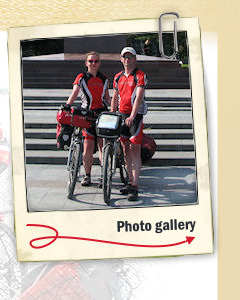Bakhchisaray
Big puddles of water indicated that it must have been raining harder there. Drivers were more than polite, slowing down to avoid splashing us. The town used to be the capital of the Crimean Khanate. Bakhchisaray inspired many artists. Adam Mickiewicz dedicated a couple of "Crimean Sonnets" to it and Pushkin wrote "The Fountain of Bakhchisaray". The most important architectural monument is the Khan's Palace. It really impressed us, being as beautiful inside as it is outside. A little bit down the road, after a 40-minute walk through the old part of Bakhchisaray, we reached Uspensky (Dormition) Cave Monastery – one of the oldest shrines in Crimea. It was probably built between 8th and 9th centuries, when larger groups of Christian monks appeared in Crimea. Facing problems during the Soviet period, the monastery had its ups and downs over the years, but it was reopened in 1993. Walking further, we got to Chufut-Kale, from where we admired a superb panoramic view over surrounding valleys and mountains. It is the best preserved cave city in Crimea, formerly an important craft and trade centre. The remains of the city are impressive. We also noted a path carved in the rock. By the end of the stroll it started pouring down and a storm broke loose. We had an opportunity to see how the rocky path served as a drain. Since it did not stop raining, we took shelter in one of the buildings – today a gallery. We were a bit hungry. Tea was available, so we ordered a pot, along with delicious, crispy, sweet apple dumplings. We waited until the heavy rain subsided and then, wearing waterproof clothing, we walked down the hill.




